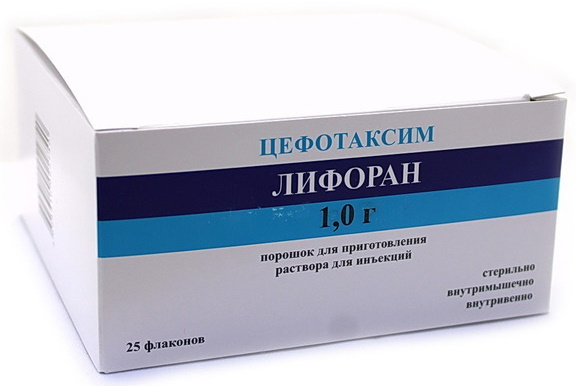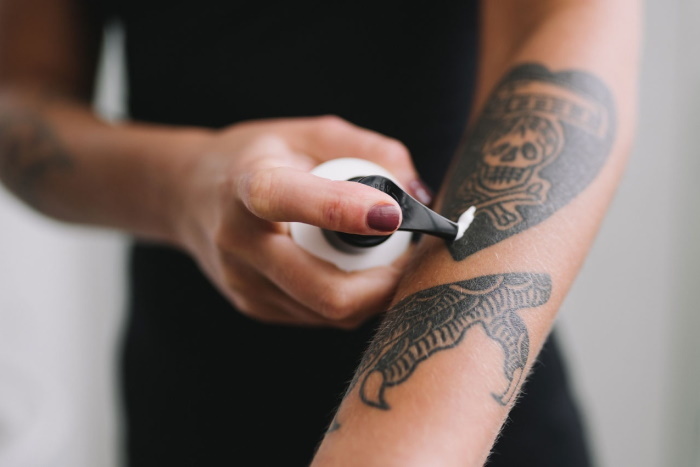Content
- Indications for use
- Chemical composition
- Ceftriaxone
- Lidocaine
- Pharmacodynamics and pharmacokinetics
- Application
- For adults
- For pregnant
- For the elderly
- Contraindications
- Overdose
- Side effects
- Special recommendations
- Analogs
- Cefazolin
- Cefotaxime
- Amikacin
- Ceftriaxone dilution video
Inject Ceftriaxone in pure form intramuscularly it is quite painful and unpleasant, therefore it is recommended to dilute it with 1% lidocaine solution. In the presence of 2% solvent, additional water for injection is required. Lidocaine can reduce pain during the injection.
Indications for use
The instructions for the antibiotic indicate that it is prescribed for infections that have been provoked by bacteria sensitive to the drug.
Intramuscular injections are prescribed for the following pathologies:
- Lyme disease
- typhoid fever;
- inflammation of the epiglottis;
- infections of the skin, soft, articular, bone tissues, respiratory and ENT organs, as well as the abdominal cavity;
- infectious lesion of the maxillofacial region;
- infected wounds or burns;
- meningitis;
- uncomplicated gonorrhea, as well as when the pathology is provoked by microorganisms secreted by penicillinase;
- salmonellosis;
- sepsis;
- septicemia;
- syphilis;
- cystitis, prostatitis, pyelitis, pyelonephritis;
- chancroid;
- endocarditis.
The medicine is suitable for the perioperative prophylactic period and for the treatment of patients with a weakened immune system.
Lidocaine is required to dilute the antibiotic so that the injections are less painful. Thanks to the solvent, treatment with Ceftriaxone is easy. However, this combination is possible only with intramuscular injection. For intravenous injection, the antibiotic must be dissolved in water.
Chemical composition
Ceftriaxone is presented in the form of a powder with a crystalline structure, yellowish or white. Moreover, it is weakly hygroscopic. Lidocaine is a colorless, transparent or slightly colored liquid.
Ceftriaxone
1 container contains 1.071 g of sodium ceftriaxone. 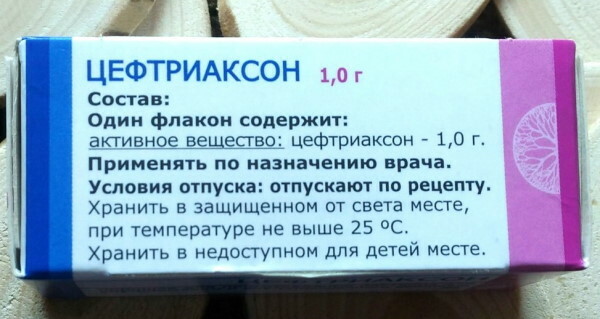 The medicine is intended for the manufacture of injections for intramuscular and intravenous administration.
The medicine is intended for the manufacture of injections for intramuscular and intravenous administration.
Lidocaine
1 ml of the composition contains 20 mg of lidocaine hydrochloride.
The following are considered additional components of the pain reliever:
- water for injections;
- sodium hydroxide;
- sodium chloride.
Pharmacodynamics and pharmacokinetics
The pharmacokinetic aspect of the antibiotic is non-linear. The main parameters that are based on the total dosage of the drug, apart from the elimination half-life, will depend on the concentration.
After a single intramuscular injection of 1 g of powder, the high plasma concentration reaches approximately 81 mg per 1 liter. The absorption process will occur within 3 hours from the moment of administration. The bioavailability of the antibiotic after intramuscular injection reaches 100%.
The amount of distribution of the main drug will reach from 7 to 12 liters. From the moment a dosage of 1 or 2 g is introduced, the agent will penetrate into organic fluids with tissues. During the day, the antibiotic indicators will be significantly higher than small overwhelming accumulations for many infectious sources in 60 fluids and tissues, taking into account secretions of the prostate gland, synovial, pleural and cerebrospinal fluids, bones, nasal mucosa, middle ear, tonsils, liver, biliary tract, heart and lungs.
When used intravenously, the antibiotic enters the cerebrospinal fluid over a short period of time. Here, the bactericidal concentration of relatively sensitive microorganisms will remain throughout the day.
Ceftriaxone has an inverse contact with albumin, the level of binding of which will decrease with increasing content. For example, if the plasma is less than 100 mg per liter, it decreases from 95% to 85% at 300 mg per liter. Since the interstitial fluid contains a small amount of albumin, the percentage of free Ceftriaxone will be higher than in plasma.
The antibiotic is able to penetrate the placental barrier and pass into breast milk in a small volume.
The drug does not have a systemic metabolism, therefore, under the influence of the intestinal microflora, it begins to turn into inactive metabolites.
Plasma release of ceftriaxone reaches about 22 ml per minute, renal clearance - up to 12 ml per minute. About 60% of the drug is excreted in the urine in an unchanged state, 50% - together with bile in an unchanged state. In adults, the half-life reaches approximately 8 hours.
If the patient has liver or kidney dysfunctions, the pharmacokinetic side will be insignificant, there is only a slight increase in the half-life stage. With renal dysfunctions, the process of release with bile is prolonged, with hepatic disorders, the process of renal cleansing increases.
In elderly people over 75 years of age, the half-life will be 2 or 3 times higher than in relatively young adults.
In newborns, approximately 70% of the dosage is excreted through the kidneys. In infants, during the first 8 days, excretion is 2 or 3 times higher than in adults.
Due to the inhibition of membrane cell synthesis, the bactericidal activity of the antibiotic is determined. It is characterized by a wide range of effects with respect to gram-positive and gram-negative microorganisms. At the same time, it shows high resistance to many substances that are produced by gram-negative and gram-positive bacteria.
Application
To dilute Ceftriaxone, a 1% solution of Lidocaine is required. For 1 g of the composition, 3.5 ml of solvent is enough. If only a 2% solution of pain reliever is commercially available, it must be diluted with water to achieve the optimal concentration. To do this, you need to mix 3 components in 1 ampoule.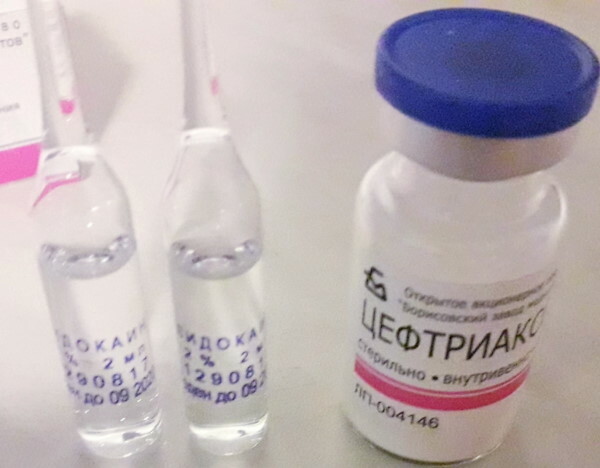
For 1 injection you need:
| Name | Dosage | Quantity |
| 2% Lidocaine | 2 ml | ampoule |
| Water for injections | 2 ml | ampoule |
| Ceftriaxone | 1 g | bottle |
If only part of the injection is required, the required volume should be taken after mixing. The ready-made solution can be stored in the refrigerator compartment for 12 hours. Lidocaine cannot be replaced with Novocaine, because a factor in the development of serious allergic reactions is likely.
To dilute 1 g of Ceftriaxone with water and 2% Lidocaine solution, you will need:
- In a 5 ml syringe, draw 2 ml of water for injection.
- After opening the ampoule with 2% Lidocaine solution, draw the solution into the syringe.
- Remove the protective sheath from the Ceftriaxone vial by piercing the rubber cap with a needle.
- Introduce the contents of the syringe into the vial.
- Shake the mixture of solvent and antibiotic vigorously to make the solution clear.
After mixing, the solution in the required volume can be transferred back to the syringe by changing the needle and injecting into the gluteus muscle. It is recommended to prepare a solution based on Ceftriaxone, water and Lidocaine for a single administration. If only 1/2 of the injection is required, it is advisable to store the remainder in a vial and keep in a cool place.
Ceftriaxone with lidocaine should be injected without water for injection according to the following scheme:
- Fill a 5 ml syringe with an anesthetic solution in an amount of 3.5 ml.
- Transfer the pain reliever to the opened antibiotic bottle. Shake the composition vigorously until it is completely dissolved.
- Pour the solution into a syringe.
- After changing the needle, evacuate the air from the syringe and inject.

It is recommended to change the needle before injecting, as the antibiotic powder can clog the holes of the needle during dissolution.
For 1 intramuscular injection, only 1 g of medication is required. The injection must be done once a day. For the introduction of 2 g of antibiotic, the dosage should be divided by 2 times 1 g each. At least 12 hours should pass between each injection, and it is required to change the side each time. At higher dosages, the patient is prescribed a dropper once or twice a day.
For adults
Ceftriaxone with Lidocaine can be injected into children from 12 years of age, adolescents weighing more than 50 kg and adults. To dilute 1 g of an antibiotic, 3.5 ml of 1% lidocaine solution is required. If you have 2% pain reliever, you will need 2 ml of solvent and 2 ml of water.
The doctor selects the dosage of the antibiotic on an individual basis, since it will depend on the diagnosis and the severity of the infectious pathology.
For pregnant
Pregnant women need to inject ceftriaxone with lidocaine once a day by injecting into the gluteus muscle. For breeding, 1% or 2% lidocaine is suitable. Novocaine is contraindicated because it can provoke the development of an allergic reaction. For 1 g of antibiotic, 3.5 ml of anesthetic will be required, for 0.5 g - 2 ml of solution.
The treatment course will depend on the severity of the condition:
- with moderate severity, treatment will continue for 10 days, with injections once a day;
- in case of serious lesions, the dosage should be increased to 2-4 g per day, while the treatment course will last 2 weeks;

- for renal dysfunctions, the daily dosage should be no more than 2 g.
For the elderly
For older people, it is recommended to administer the standard dose that is intended for adults. This does not need to take into account the patient's age.
Contraindications
Injecting ceftriaxone with lidocaine is contraindicated if there is a hypersensitivity to the active substance or auxiliary ingredients of the drug.
The following are considered relative restrictions:
- prematurity;
- newborns, if they have an imbalance between the formation and release of bilirubin;
- hepatic or renal failure;
- enteritis or colitis, which is associated with the use of antibacterial compositions;
- stage of pregnancy and breastfeeding.
It is permissible to inject the antibiotic in its pure form, without the use of a solvent in such cases:
- allergic reaction;
- droppers with intravenous injections, otherwise the heart rhythm is disturbed;
- restrictions on the solvent in the form of breastfeeding, pregnancy, old age, heart block, circulatory failure, liver pathologies.
For dilution, you will need exclusively purified water in a dosage of 4 ml, since injections of the medicine into the gluteus muscle will be painful if you do not add anesthetic.
Overdose
In case of an overdose, the following symptoms may occur:
- headache;
- high sweating;
- dizziness;
- hives;
- fever;
- chills;
- clouding of consciousness;
- convulsions;
- rash;
- nausea with gag reflexes.

However, there are no specific antidotes. With the help of hemodialysis, an excessively high concentration of an antibiotic in the blood plasma cannot be reduced. As a treatment for an overdose, symptomatic measures will be required.
Side effects
After the injection, side effects may occur in the form of:
- anemia, nosebleeds, leukocytosis, thrombocytosis;
- glossitis, diarrhea, stomatitis, taste disturbances, gas in the intestines, nausea and vomiting;
- dizziness and pain in the head;
- dysbiosis, candidiasis;
- chills, anaphylactic shock, serum sickness, skin rash, swelling, urticaria, pruritus, fever;
- poor excretion of urine.
It is permissible to dilute ceftriaxone with lidocaine if it must be injected into the muscle. Intravenous injections must be performed in water. When using droppers, the solvent can be 5% glucose or saline.
In case of accidental injection of an antibiotic and an intravenous pain reliever, the following may occur:
- the rhythm of contractions slows down, as a result, the myocardium with the brain will not receive the required volume of blood;
- a disorder of the conduction of the heart muscle, and the nutrition of vital internal organs is suspended;
- vascular collapse, fainting;
- decline or sharp increase in blood pressure.
If the patient has heart and liver failure, as well as intolerance to Lidocaine, it is better to use water for injection as a solvent. If you experience unbearable pain sensations, it is recommended to change intramuscular injections to intravenous ones or put a dropper. Also, the doctor can change the antibiotic for another medicine that has a broad antibacterial effect.
Special recommendations
To dilute the antibiotic, lidocaine is required at a concentration of 1%. However, in this form, the solvent is extremely rare, therefore it is permissible to dilute a 2% solution to 1%. In this case, 2 ml of 2% pain reliever will require 2 ml of water for injection.
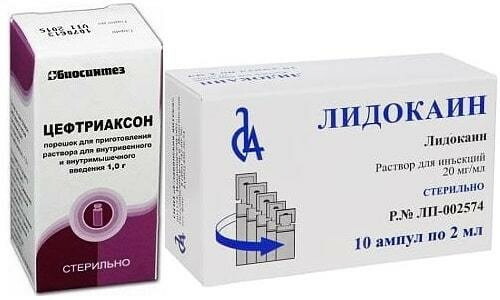
The instructions for the tool indicate that the dosage of the anesthetic should be no more than 3.5 ml. When diluted with a 2% solution, the volume increases to 4 ml. However, this discrepancy will not affect the treatment process. However, a large amount of pain reliever will be better because the antibiotic is difficult to dissolve.
Analogs
In the absence of Ceftriaxone, it can be replaced with quality analogues. However, they may differ from the main drug in the active ingredient and the mechanism of action. Therefore, before choosing a substitute, it is recommended to consult with your doctor.
Cefazolin
The antibiotic is a first-generation drug that has been in high demand for 25 years. It helps break down the cell wall of bacteria. At the same time, the drug has a dry antimicrobial spectrum and shows a high result in relation to streptococcal and staphylococcal infections.
The drug costs about 29 rubles.
Cefotaxime
The analogue is more suitable for the treatment of jaundice, if necessary, the introduction of calcium, as well as for premature newborns. For adults with concomitant cardiac pathologies, bleeding, ulcerative colitis, as well as in the 2nd and 3rd trimester of pregnancy, it is better to choose Ceftriaxone.
Basic drug therapy is easier and cheaper because only 1 injection is required without changing the dosage for renal failure. Regarding the type of microbes that they destroy, and the antibacterial effect, the 2 antibiotics do not differ. However, the difference may be present in contraindications and side effects.
The cost of an analogue starts at 13 rubles.
Amikacin
Amikacin with Ceftriaxone are broad-spectrum antibiotics. They are often prescribed for bacterial infections of the bones, skin, abdomen, respiratory and urinary tract.
If the membranes of the brain are inflamed or in the presence of bronchopneumonia, preference should be given to Ceftriaxone, since the analogue is contraindicated in renal lesions and auditory decrease.
The cost of Amikacin varies within 900 rubles.
Before the injection, Ceftriaxone must be mixed with a 1% solution of Lidocaine so that the painful sensations when injected into the gluteus muscle are less sensitive. If the drug is intended for intravenous administration, it must be diluted with glucose, saline or water.
Ceftriaxone dilution video
Ceftriaxone + Lidocaine + Water. How to dilute:


